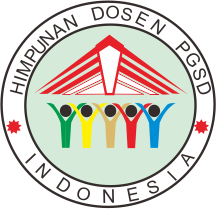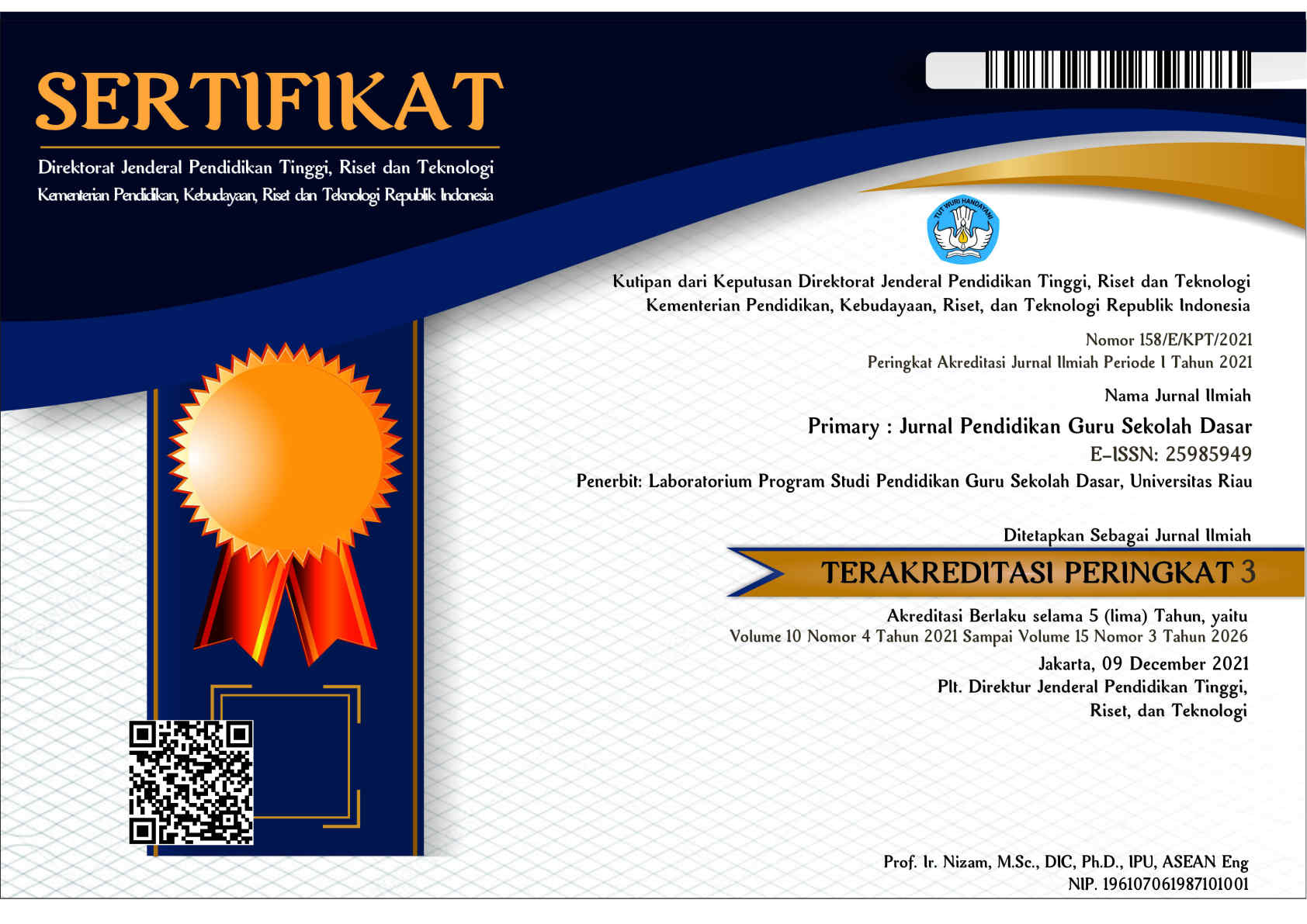The Effectiveness of Hybrid Project-Based Learning Model in Improving Primary Teacher Education Students’ Critical Thinking and Creative Thinking Skills
Abstract
This paper examines the effectiveness of the hybrid project-based learning model to improve students’ critical thinking and creative thinking skills. The research is quantitative research with a pretest-posttest control group design. The subjects involved elementary school teacher education students in the second semester of the academic year 2022/2023 at Universitas Muhammadiyah Lamongan. The research can be applied to students during the learning process. The measured research data were validity, practicality, and effectiveness of the research instrument. The results indicate that (a) the result of validity testing of the developed hybrid project-based learning model was very valid with a percentage of 94%. In addition, (b) the questionnaire analysis result of students’ responses in the experimental class was very good with a percentage of 94% while the result in the control class was 69% in the unfavorable category. Moreover, (c) the t-test analysis 0.023 < 0.05 with the N-Gain test results was 79.20%, which means that there was a significant difference and an increase in students’ critical thinking skills. And (d) the t-test analysis 0.019 <0.05 with the N-Gain test results was 77.11%, which means that there was a significant difference and an increase in students’ creative thinking skills. In conclusion, the hybrid project-based learning model is feasible to use and can improve students’ critical thinking and creative thinking skills.
Keywords
Full Text:
PDFReferences
Anjarsari, P. 2014. Literasi Sains Dalam Kurikulum Dan Pembelajaran IPA SMP. edited by U. N. Yogyakarta. Yogyakarta.
Arifin, Z. 2012. Penelitian Pendidikan Metode Dan Paradigma Baru. Bandung: PT Remaja Rosdakarya.
Bernie Trilling, C. F. 2012. 21st-Century Skills: Learning for Life in Our Times. John Wiley & Sons.
Blevins, B. 2018. “Teaching Digital Literacy Composing Concepts: Focusing on the Layers of Augmented Reality in an Era of Changing Technology.” Computers and Composition 50:21–38. doi: https://doi.org/10.1016/j.compcom.2018.07.003.
Boaler, J. 1997. Experiencing School Mathematics: Teaching Styles, Sex, and Setting. Open University Press.
Buku, M. N. I., Mite, Y., Fauzi, A., Widiansyah, A. T., & Anugerah, D. Y. 2015. “Penerapan Pembelajaran Cooperative Script Berbasis Lesson Study Sebagai Upaya Peningkatan Keaktifan Lisan Dan Kecakapan Sosial Mahasiswa SI Pendidikan Biologi Matakuliah Strategi Belajar Mengajar.” Pp. 603–606 in Proceedings of the 2nd Seminar & Workshop Nasional Biologi, IPA, Dan Pembelajarannya FMIPA UM. Proceedings of the 2nd Seminar & Workshop Nasional Biologi, IPA, Dan Pembelajarannya FMIPA UM.
Conley, D. T. 2007. Toward a More Comprehensive Conception of College Readiness (Issue March). Educational Policy Improvement Center.
Dewi, U. 2020. Model Project Based Online Learning (1st Ed.). CB Beta Aksara.
Dimyati, &. Mudjiono. 2006. Belajar Dan Pembelajaran. Rineka Cipta.
Diyanni, R. 2016. Critical and Creative Thinking: A Brief Guide for Teachers. West Sussex: UK: John Wiley & Sons, Inc.
Drew, S. V. 2012. “Open up the Ceiling on the Common Core State Standards: Preparing Students for 21st-Century Literacy-Now.” Journal of Adolescent and Adult Literacy 56(4):321–330. doi: https://doi.org/10.1002/JAAL.00145.
Dunlosky, J., Rawson, K. A., Marsh, E. J., Nathan, M. J., & Willingham, D. T. 2013. “Improving ‘students’ Learning with Effective Learning Techniques: Promising Directions from Cognitive and Educational Psychology.” Psychological Science in the Public Interest, Supplement 14(1):4–58. doi: https://doi.org/10.1177/1529100612453266.
Ersoy, E., & Başer, N. 2014. “The Effects of Problem-Based Learning Method in Higher Education on Creative Thinking.” Procedia - Social and Behavioral Sciences 116:3494–3498. doi: https://doi.org/10.1016/j.sbspro.2014.01.790.
Firdausi, F. J. 2020. Wacana Penerapan Hybrid Learning Oleh Kemendikbud. https://osf.io/5w2hk.
Fisher, A. 2007. Critical Thinking: An Introduction. Cambridge: Cambridge University Press.
Husamah. 2015. “Thinking Skills for Environmental Sustainability Perspective of New Students of Biology Education Department through Blended Project-Based Learning Model.” Jurnal Pendidikan IPA Indonesia 4(2):110–119. doi: https://doi.org/10.15294/jpii.v4i2.3878.
Irmaningrum, R. N., Zativalen, O., & MZ, A. S. A. 2023. “The Development Of E-Comics Media Based On The Vark Model To Measure The Understanding Of Elementary School Students.” EDUHUMANIORA: Jurnal Pendidikan Dasar 15(1).
Kaur, S. 2013. “HRM in 21 St Century: Challenges of Future.” International Journal of Emerging Research in Management &Technology 9359(26):2278–9359.
Kharisma, A. I., MZ, A. S. A., Handoyo, E., & Widiyanti, W. 2023. “The ‘7 Wonders of the World-APP’ Augmented Reality-Based Media to Improve Elementary School Students’ Conceptual Understanding.” Jurnal Ilmiah Sekolah Dasar 7(1):18–26. doi: https://doi.org/10.23887/jisd.v7i1.54642.
Kokotsaki, D., Menzies, V., & Wiggins, A. 2016. “Project-Based Learning: A Review of the Literature.” Improving Schools 19(3):267–277. doi: https://doi.org/10.1177/1365480216659733.
López-Pérez, M. V., Pérez-López, M. C., & Rodríguez-Ariza, L. 2011. “Blended Learning in Higher Education: Students’ Perceptions and Their Relation to Outcomes.” Computers and Education 56(3):818–826. doi: https://doi.org/10.1016/j.compedu.2010.10.023.
Magnus, D. D. M., Carbonera, L. F. B., Pfitscher, L. L., Farret, F. A., Bernardon, D. P., & Tavares, A. 2020. “An Educational Laboratory Approach for Hybrid Project-Based Learning of Synchronous Machine Stability and Control: A Case Study.” IEEE Transactions on Education 63(1):48–55. doi: https://doi.org/10.1109/TE.2019.2956909.
Masigno, R. M. 2014. “Enhancing Higher Order Thinking Skills in a Marine Biology Class through Problem-Based Learning.” Asia Pacific Journal of Multidisciplinary Research 2(5):1–6.
McFarlane, D. A. 2013. “Understanding the Challenges of Science Education in the 21st Century: New Opportunities for Scientific Literacy.” International Letters of Social and Humanistic Sciences 4:35–44. doi: https://doi.org/10.18052/www.scipress.com/ilshs.4.35.
Movahedzadeh, F., Patwell, R., Rieker, J. E., & Gonzalez, T. 2012. “Project-Based Learning to Promote Effective Learning in Biotechnology Courses.” Education Research International 2012:1–8. doi: https://doi.org/10.1155/2012/536024.
Mustaji, S. M., & Pradana, H. D. 2022. “Development of Hybrid Project-Based Learning in State University of Surabaya.” In Innovation on Education and Social Sciences (Routledge):11–18.
MZ, A. S. A., Aprillya, M. R., & Bianto, M. A. 2022. “Science Augmented Reality Program Media for Elementary School Students.” JPI (Jurnal Pendidikan Indonesia) 11(3). doi: https://doi.org/10.23887/jpiundiksha.v11i3.41378.
MZ, A. S. A., Mudayan, A., Mubarok, M. S., & Dewantari, S. M. 2022. “Grandparenting Pembentukan Karakter Siswa Sekolah Dasar Pada Pelaksanaan Pembelajaran Jarak Jauh (Pjj) Pada Masa Pandemi Covid-19.” VOX EDUKASI: Jurnal Ilmiah Ilmu Pendidikan 13(1):114–24. doi: https://doi.org/10.31932/ve.v13i1.1546.
MZ, A. S. A., Rusijono, R., & Suryanti, S. 2021. “Pengembangan Dan Validasi Perangkat Pembelajaran Berbasis Problem Based Learning Untuk Meningkatkan Keterampilan Berpikir Kreatif Siswa Sekolah Dasar.” Jurnal Basicedu 5(4):2685–90. doi: https://doi.org/10.31004/basicedu.v5i4.1260.
Nagappan, R. 2010. “Teaching Thinking Skills at Institutions of Higher Learning: Lessons Learned.” Pertanika Journal of Social Science and Humanities 18:1–14.
Napier, N. P., Dekhane, S., & Smith, S. 2011. “Transitioning to Blended Learning: Understanding Student and Faculty Perceptions.” Journal of Asynchronous Learning Network 15(1):20–32. doi: https://doi.org/10.24059/olj.v15i1.188.
Nurdiansah, I., & Makiyah, Y. S. 2021. “Efektivitas Modul Hybrid Project Based Learning (H-Pjbl) Berbasis Laboratorium Untuk Meningkatkan Keterampilan Proses Sains Siswa.” Jurnal Pendidikan Fisika Dan Teknologi 7(2):104–10.
Oktadifani, U., Lesmono, A. D., & Subiki, S. 2017. “Pengaruh Model Project Based Learning Terhadap Keterampilan Proses Sains Dan Hasil Belajar Siswa Dalam Pembelajaran Fisika Di SMA.” Jurnal Pembelajaran Fisika 5(2):109–14.
Osman, K., Tuan Soh, T. M., & Arsad, N. M. 2010. “Development and Validation of the Malaysian 21st Century Skills Instrument (M-21CSI) for Science Students.” Procedia – Social and Behavioral Sciences 9:599–603. doi: https://doi.org/10.1016/j.sbspro.2010.12.204.
Paul, R. & Elder, L. 2014. Critical Thinking: Tools for Taking Charge for Your Professional and Personal Life. New Jersey: US: Pearson.
Rahardjanto, A. 2019. “Hybrid-PjBL: Learning Outcomes, Creative Thinking Skills, and Learning Motivation of Preservice Teacher.” International Journal of Instruction 12(2):179–92.
Railsback, J. 2002. “Project-Based Instruction: Creating Excitement for Learning.” By Request Series.
Ritter, S. M., & Mostert, N. 2017. “Enhancement of Creative Thinking Skills Using a Cognitive-Based Creativity Training.” Journal of Cognitive Enhancement 1(3):243–253. doi: https://doi.org/10.1007/s41465-016-0002-3.
Sadikin, A., & Hamidah, A. 2020. “Pembelajaran Daring Di TengahWabah Covid-19.” Biodik 6(2):109–119. doi: https://doi.org/10.22437/bio.v6i2.9759.
Sudjana, N., &Rivai, A. 2001. Penggunaan Media Pengajaran Dalam PBM. Bandung: Sinar BaruAlgensindo.
Sudjana, N., &. Ibrahim. 2009. Penelitian Dan Penilaian Pendidikan. Sinar Baru Algensindo.
Sugiyono. 2013. Metode Penelitian Kuantitatif Dan Kualitatif Dan R&D. Bandung: Alfabeta.
Trimawati, K., Kirana, T., & Raharjo, R. 2020. “Pengembangan Instrumen Penilaian Ipa Terpadu Dalam Pembelajaran Model Project Based Learning (Pjbl) Untuk Meningkatkan Kemampuan Berpikir Kritis Dan Kreatif Siswa Smp.” Quantum: Jurnal Inovasi Pendidikan Sains 11(1):36.
Trisnowati, E. 2022. “Hybrid Project-Based Instructional Model: Fostering Critical Thinking Skills and Creative Thinking Skills.” Indonesian Journal of Science and Education 6(1):29–35. doi: https://doi.org/10.31002/ijose.v6i1.92.
Wilson, K. 2016. “Critical Reading, Critical Thinking: Delicate Scaffolding in English for Academic Purposes (EAP).” Thinking Skills and Creativity 22:256–265. doi: https://doi.org/10.1016/j.tsc.2016.10.002.
Zikri, A., Darvina, Y., & Sari, S. Y. 2020. “Perbandingan Peningkatan Keterampilan Berpikir Kritis Dan Kreatif Siswa Dengan Menerapkan Lks Berbasis Problem Solving Dan Inkuiri Terbimbing Pada Materi Kalor Dan Teori Kinetik Gas Kelas XI SMAN 2 Padang.” Pillar of Physics Education 13(1).
DOI: http://dx.doi.org/10.33578/jpfkip.v12i5.9967
Refbacks
- There are currently no refbacks.
Copyright (c) 2023 AF Suryaning Ati MZ

This work is licensed under a Creative Commons Attribution-NonCommercial-ShareAlike 4.0 International License.
____________________________________________________________
Primary: Jurnal Pendidikan Guru Sekolah Dasar
Secretariat
Program Studi Pendidikan Guru Sekolah Dasar
Gedung B1, FKIP Universitas Riau
Kampus Bina Widya Km. 12,5 Simpang Baru Panam
Pekanbaru Riau Indonesia 28293
e-mail : primary@ejournal.unri.ac.id



